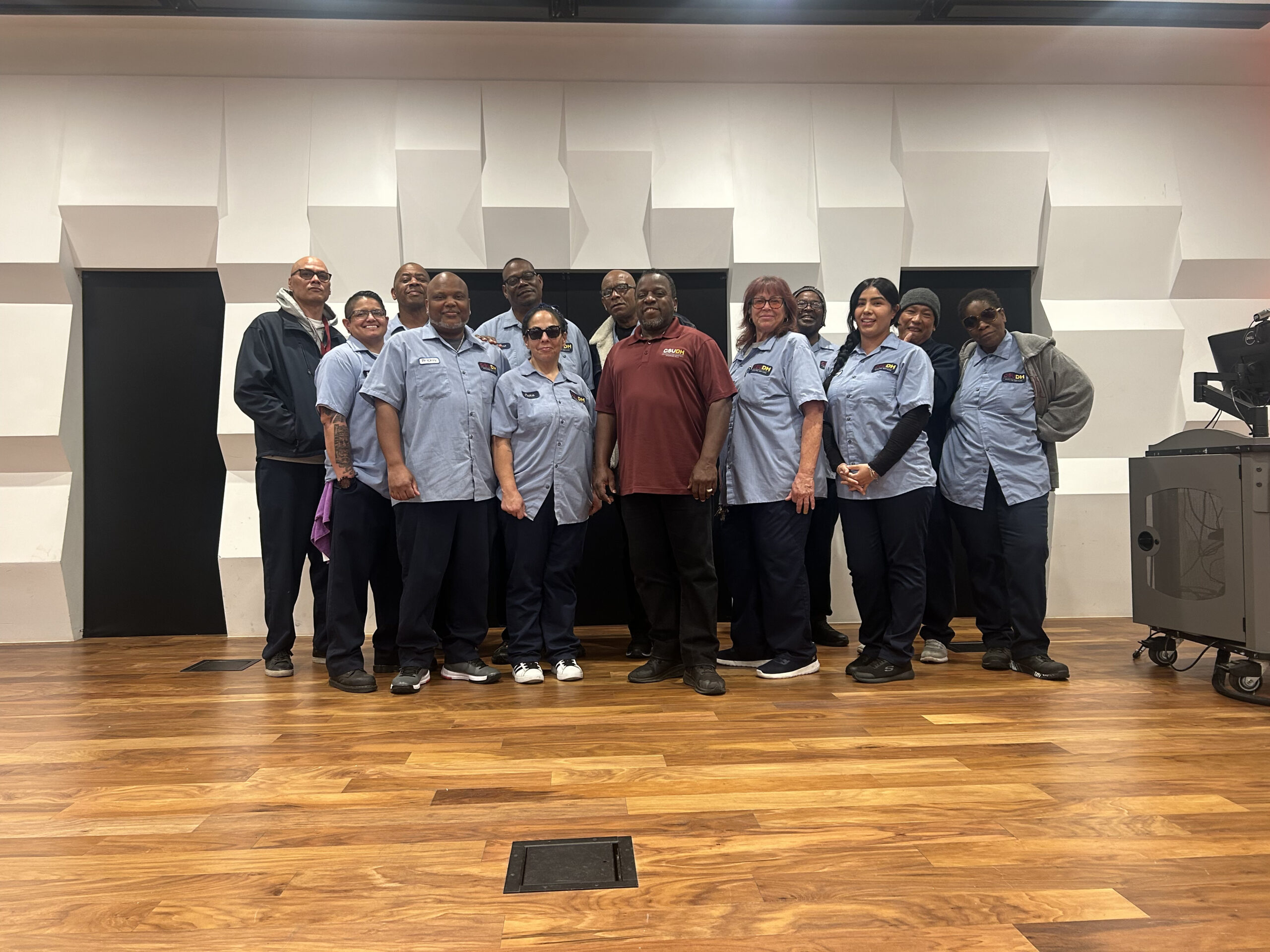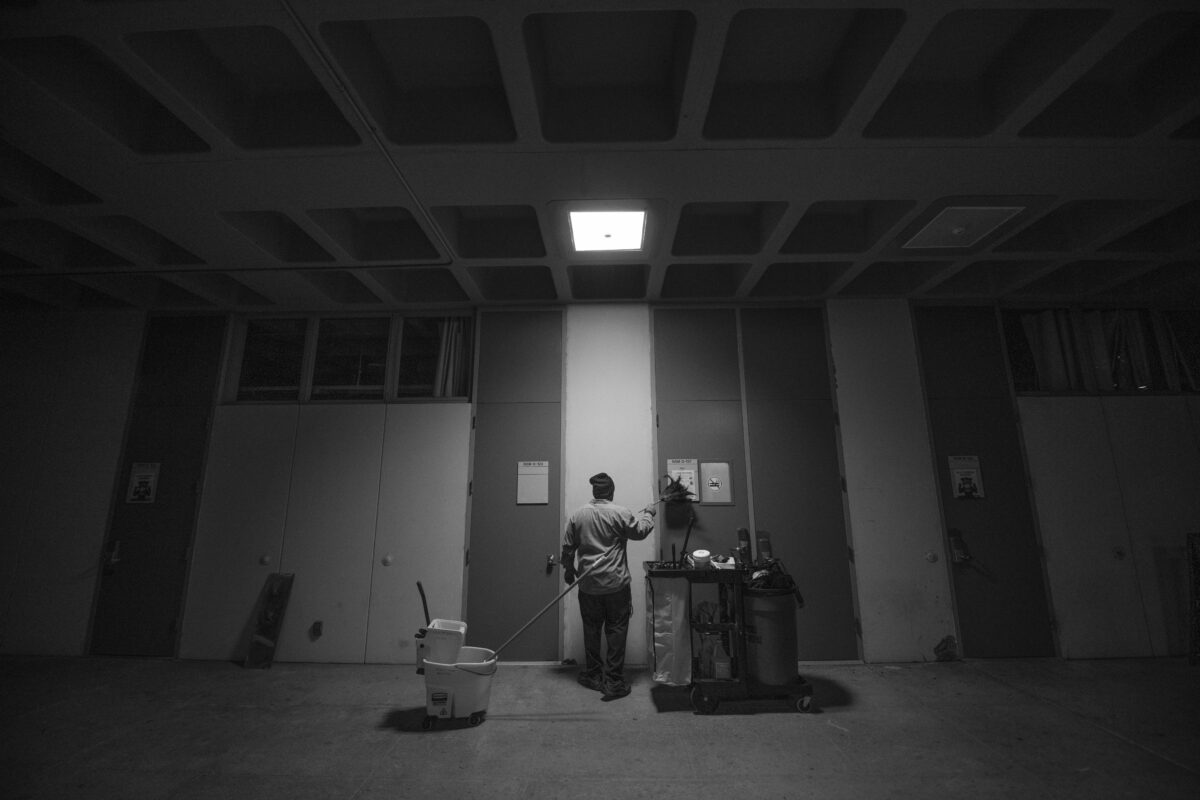As budget rollbacks strain staffing, CSUDH custodians continue to show up—cleaning, caring, and holding the campus together.
By Andrea Ambriz, Staff Reporter
As the sun rises over Dominguez Hills, campus custodians like Eva Rodriguez are already at work — mopping, wiping down surfaces, and preparing classrooms. It’s a demanding job, one that some in the campus community might take for granted every day. In recent months, though, the duties have become more involved, while the crew has become smaller.
This past January, custodial services assistant manager Byron Hudson was forced to layoff four custodians. The cuts were part of a broader wave of budget rollbacks affecting the entire California State University system. The budget crisis has put a squeeze on the custodial staff, Hudson said, making it more difficult for the team to do their jobs.
“The hardest part of my job is just navigating through the daily schedule, knowing that I’m short-staffed,” said Hudson, who first joined the crew in February 2001.
Rodriguez said the burden of the layoffs has fallen hardest on those still on the job. “I think that we are the ones that feel it more than anybody,” she said.
Lead custodian Rachel Young echoed Rodriguez, telling The Bulletin that the workload is more stressful but the crew continues to show up and do the work.
“We still have to try and keep a safe environment for you guys,” Young said. “We still try to keep things sanitized and looking good for when you guys come here.”
The custodial job is often overlooked. While the needs of students, professors, and administrators tend to come first, keeping the campus clean is paramount. Although Hudson lost four employees this semester, day-to-day staffing varies due to other absences. Some employees live with chronic illness or injury, while others have to call out sometimes to take care of responsibilities off-campus.
“I average between seven to nine people missing every day,” Hudson said. “Circumstances change daily. We don’t know what’s going to happen from day to day.”
With fewer workers, remaining custodians are often assigned additional tasks. “We come in and we do that assignment when they’re not here—and we still have our own assignment,” Rodriguez said.
Although the four laid-off employees were probationary custodians, Hudson said they made a significant impact.
“They were all superstars with a lot of knowledge and energy,” he said. “They were vital cogs to the operation that I oversee.”

Duties, demands, and everyday routines
Custodians prioritize areas that students use most frequently. Restrooms receive detailed cleaning every day, followed by classrooms. Offices and other lower-traffic areas may not get cleaned as regularly, especially these days.
“Because of their vacancies, it may or may not happen,” Hudson said.
The custodial team operates across three shifts: day, evening, and night. Responsibilities vary depending on the shift.
“All shifts are different,” Young explained. “Night shifts do more detailing work, wiping desks, vacuuming floors, mopping, bathrooms, spots, spills, refinish the floors or do carpets.”
When the campus is busy during the day, the crew prioritize bathrooms and other areas in need of immediate attention to avoid disrupting the flow of traffic, Rodriguez said. “We don’t want to get in your way.”
Cleaning through crises, from COVID to cuts
COVID-19 had a profound impact on campus. Five years after Toros first transitioned to remote learning, the effect of the pandemic continues to reverberate across campus. Some crew members were concerned about safety on campus, Young said, while others were unable to come back to work.
“We did lose a few during that time, because of COVID,” Young said.
During the pandemic, crew members were reassigned from early morning shifts to graveyard shifts to complete work before others arrived on campus. Even with fewer people on campus, custodians were still responsible for keeping the university clean and sanitized.
“As [COVID] got better, budget got worse. So we had to go back on the schedule,” Rodriguez said, adding that she liked working days but felt she got more done at night.
When Toros started returning to campus in the spring of 2022, Hudson noted that it was “all hands on deck.”
The crises have helped the crew forge stronger bonds with each other, Young said, adding that crew members “found a cape” and met the moment. “I want to say that it actually brought us a little closer, as family.”
Budget cuts spark uncertainty
Given the recent budget rollbacks, crew members cannot help but worry about what the recent rollbacks could mean for their jobs down the line.
In October 2024, the university administration promised seniority-based pay raises, but those remain unresolved. Custodians have also operated under an unspoken understanding that their benefits would be protected — though that, too, seems to remain unclear.
“We just don’t know yet,” Young said. Despite the uncertainty, she added, the custodial staff at CSUDH takes great pride in their service to the campus community.
“It feels like home,” Young said. “Yes, we’re doing it for a check. Yes, we wish we can have more money, but at the end of the whole day, we’re doing it for the students.”
Hudson, the assistant manager, also expressed pride in his team.
“The success of our department is on them, the custodians—they are the boots on the ground,” Hudson said. “We are making a difference, we are making an impact, and we are appreciated.”

